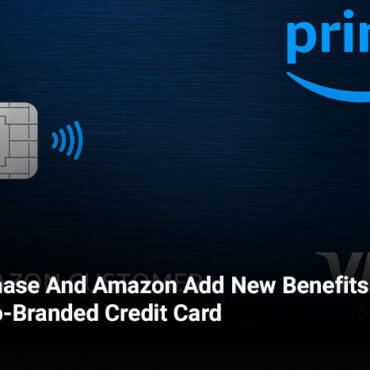
Chase And Amazon Add New Benefits to Co-Branded Credit Card
Chase Bank and Amazon announced new benefits and features for the co-branded Amazon Visa card. Cardholders will have increased options to earn cash back and chances to earn and redeem […]
 play_arrow
play_arrow
Episode 119 – (Interview) with Sheila Butler – Founder and CMO of Butler Marketing Group admin
 play_arrow
play_arrow
Episode 118 (Interview) with Dan Kustelski – Co-Founder of Chalkline admin
 play_arrow
play_arrow
Episode 117 (Interview) with Len Covello – CTO of Engage People admin
 play_arrow
play_arrow
Episode 116 – (Interview) with Lee-Ann Johnston – Founder of AffiliateINSIDER admin
 play_arrow
play_arrow
Episode 115 – (Interview) with John Bertino – Owner and Founder of The Agency Guide admin
 play_arrow
play_arrow
Episode 114 – (Interview) With Nick Ewen – Director of Content for The Points Guy admin
 play_arrow
play_arrow
Episode 110 – (Interview) with Zachary Slingsby – Founder of Human Factor Media admin
 play_arrow
play_arrow
 play_arrow
play_arrow
Episode 108 (Interview) with John Nantz – Founder and Strategy Consultant at Redwood Advisors admin
 play_arrow
play_arrow
Episode 107 (Interview) with Bobby Gillespie Founder and Principal at Propr Design admin
 play_arrow
play_arrow
Episode 106 (Interview) With Brandon Ehrhardt – Senior Director of Partner Programs at Expedia Group admin
 play_arrow
play_arrow
In today's ever-changing customer loyalty landscape, brands are seeking to revamp or enhance their loyalty efforts, while better understanding their customers. Jebbit, a SaaS platform specializes in interactive consumer engagements, such as personality quizzes, trivia, interactive look books, and product matching to power zero-party data collection.
Following the 2022 State of Customer Loyalty Report, Loyalty360 found that many brands seek to completely redo or enhance their customer loyalty programs in 2023. As brands look to make these changes, Jebbit provides insights into the value of zero-party data and how to implement it into the program to provide meaningful personalization.
Mark Johnson, CEO of Loyalty360, spoke with Pam Erlichman, Chief Evangelist Officer of Jebbit, about how to effectively collect and use zero-party data, how brands should think about customer loyalty, and how to integrate new trends and technologies into their loyalty programs.
What is Zero-Party Data?
First-party data comes from behavioral and transactional data, where a brand uses consumer clicks and purchases to infer what customers want. It comes directly from consumer actions — not collected by a third-party agency — but results in brands sending promotions and communications based on tracking consumer journeys. While behavioral and transactional data help brands personalize the customer experience more effectively than third-party data, it can feel intrusive to consumers because the brand does not ask for the information.
Zero-party data is a form of first-party data where consumers directly give their information to the brand. This type of interaction builds trust between consumers and brands because consumers understand they actively provide the brand with information instead of it coming from observations the brand makes from online interactions.
“It builds trust. It builds transparency. But more importantly, it can get to the kind of data that goes beyond the behavioral and transactional,” says Erlichman. “It can get to future needs states and emotional data – things you can’t get unless you ask a consumer directly.”
Brands who leverage zero-party data well create experiences to engage with customers in authentic ways, beyond simply handing out surveys. Erlichman uses ASICS as an example of implementing this kind of engagement successfully.
“When you sign up for the OneASICS™ loyalty program, instead of a typical lead form and receiving all the communications, they created an experience called ‘What type of runner are you?’ This is their welcome onboarding program,” says Erlichman.
With this experience, ASICS does ask about members’ running habits: How often do you run? How long do you run? However, the brand also uses this onboarding survey to gather emotional data, asking what members think about during runs and why they choose to run. Then, ASICS uses this zero-party data to send meaningful, personalized communications and offers to OneASICS™ members.
Redefining Customer Loyalty
Every brand has their own interpretation of customer loyalty and what it means within the context of their audiences. However, not every brand fully understands what customer loyalty means to their customers. Erlichman references a recent Twilio survey that found 46% of brands believe they do an excellent job at personalization, but only 15% of consumers agree.
“The way I like to think about it is that the way to win is to build more trust and understand and know your customer better than your competition,” says Erlichman.
This kind of customer loyalty helps bridge the gap between how well brands think they personalize the customer experience and their customers’ perspectives. Brands can use zero-party data to both provide more effective personalization — like ASICS — and directly ask them for feedback on improving their programs.
Additionally, building customer loyalty also involves both engaging customers and making sure they understand their full benefits with the loyalty program. However, these two ideas do not need to be mutually exclusive. Erlichman and Jebbit have seen great success with clients who gamify their loyalty program education.
“You must educate them on the benefits, but typically that turns into a long email explaining all the ways to earn and burn. Those end up being glossed over or barely read,” says Erlichman. “Returning to the ASICS example, the next step after onboarding is using trivia to gamify the benefits.”
Beyond the initial onboarding and educational process, brands need to stay top of mind with customers through continual engagement. Jebbit clothing retail clients demonstrate this through enticing customers with questions. They send out communications asking for feedback on styles and which they would choose.
“Our product match quiz templates allow clothing retailers to show their member base what’s new or seasonally relevant through questions like ‘do you like this style or that style?’” says Erlichman. “It not only gets them back into the app and engaging, but it shortens the time between purchases, increases average order value, and has driven millions in incremental value over the past few years.”
Effectively Integrating New Trends and Technologies
As brands look to integrate new technologies and trends in loyalty into their loyalty programs, Erlichman recommends taking a critical look at the purpose behind making those changes. To create effective customer engagement, it is more important for a brand’s loyalty features and technologies to create meaningful engagement rather than adding features simply because they are trending.
To Erlichman, gamification is the current trend that comes to mind. In her opinion, gamification must serve a key purpose and collect data. It should help members get to the next tier or level of engagement with the brand.
“There’s a difference between gamification for gamification’s sake and strategic gamification,” says Erlichman. “Spin-the-Wheel might get the brand an engagement for a second, but is it driving value and helping your business?”
Additionally, as brands look to integrate new technologies, they need to start with their core communications with their customers. Whether that’s an email, app push notification, SMS, or newsletter, the brand needs to examine ways to transform that communication from one-way to two-way.
“With those key engagements, brands need to ask, ‘How can I progressively learn about my loyalty members over time and — most importantly — what do I need to know about them in those key moments?’” says Erlichman.
Adding Customer Value to Zero-Party Data
When it comes to zero-party data, many brands ask for information but don’t effectively use it. Historically, many brands have a pattern of asking for any and all information they can think of but then do not act on that data. For example, Erlichman cites demographic data like age as one element brands ask for but do not use.
“Brands need to focus on the 2-3 things they can activate to affect the customer journey, what brands send them, or how brands personalize the experience,” says Erlichman.
As brands look to integrate zero-party data into their customer loyalty and personalization efforts, they must determine what value they will provide their members in exchange for the information. Acting on data lets customers know the brand is actually listening to them, which builds trust and encourages the members to continue engaging.
Before asking for data, Erlichman recommends that brands explicitly tell their members what kind of value they will receive in exchange for their information. Brands need to provide a meaningful trade to show their members that the data has value to the brand.
“Up front, to even get them to engage, what value are you giving the consumer in return for their data?” says Erlichman. “We talk with our clients about forms of genuine value that create that mutual value exchange to encourage the consumer to give you that data in the first place.”
Source link

Chase Bank and Amazon announced new benefits and features for the co-branded Amazon Visa card. Cardholders will have increased options to earn cash back and chances to earn and redeem […]
You can see how this popup was set up in our step-by-step guide: https://wppopupmaker.com/guides/auto-opening-announcement-popups/
I do the podcast commercial free and with no sponsors. If you’d like to show your support for the program, you can buy me a cup of coffee.☕️
The caffeine keeps me going!
You can see how this popup was set up in our step-by-step guide: https://wppopupmaker.com/guides/auto-opening-announcement-popups/